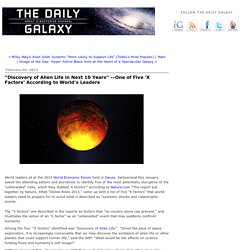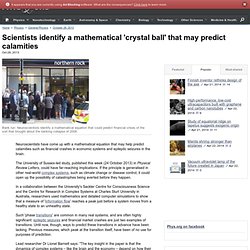

The Science of Overpopulation. One of Five 'X Factors' According to World's Leaders. The "X factors" are described in the reports as factors that "no country alone can prevent," and illustrates the notion of an "X factor" as an "unheralded" event that may suddenly confront humanity.

Among the five "X factors" identified was “Discovery of Alien Life. " "Given the pace of space exploration, it is increasingly conceivable that we may discover the existence of alien life or other planets that could support human life," said the WEF. "What would be the effects on science funding flows and humanity’s self-image? " WEF.org observed that "It was only in 1995 that we first found evidence that other stars also have planets orbiting them.
Now thousands of 'exoplanets' revolving around distant stars have been detected. Among the other X Factors: "Neuroscientists, for instance, are avidly pursuing drugs and devices that could deliver real cognitive enhancement — not just sharpening our alertness and ability to focus, as certain drugs already do, but upping our intellectual firepower.
How Chocolate Might Save The Planet : Krulwich Wonders... When you unwrap it, break off a piece and stick it in your mouth, it doesn't remind you of the pyramids, a suspension bridge or a skyscraper; but chocolate, says materials scientist Mark Miodownik, "is one of our greatest engineering creations.

" True, it begins with a cocoa bean plucked from a tree. But no one would eat a raw cocoa bean. "It tastes revolting," Miodownik says in his new book, Stuff Matters. Robert Krulwich/NPR But cut it, leave it, roast it, tinker with it for a couple of centuries (and add sugar) ... ... and cocoa beans can be totally transformed. Chocolate's Secret Chocolate bars have a circus trick, an "Oh, my" moment: They're solid when you unwrap them. The secret ingredient is cocoa butter, stored in the form of large molecules called triglycerides that come with three (thus the "tri") prongs. ... or more tightly, like this ... ... or ( I'm redrawing this from Mark's book) more richly intermeshed, like this: The denser the package, the harder the chocolate. This is What Americans Will Look like by 2050 – and it’s Stunning. With the increasing trend of interracial partnerships, it’s much more common for an individual to belong to a variety of ethnic backgrounds.

As PolicyMic bluntly summarized, “in a matter of years we’ll have Tindered, OKCupid-ed and otherwise sexed ourselves into one giant amalgamated mega-race.” They’re absolutely right. But what will that look like? To answer this question, National Geographic built its 125th anniversary issue around this theme… and what they came up with is beautiful. Renowned photographer and portrait artist, Martin Schoeller, was commissioned to capture the lovely faces of our nation’s multicultural future. And like this: And this: What’s most entrancing is that none of these photographs are photo-shopped projections, but real people. The numbers of these mixes will only grow. What does this mean for the future in terms of racism?
Race has no definition, no basis in biology, yet its constructions, functions, and mythologies irrevocably shape the world as we know it. Scientists identify a mathematical 'crystal ball' that may predict calamities. Neuroscientists have come up with a mathematical equation that may help predict calamities such as financial crashes in economic systems and epileptic seizures in the brain.

The University of Sussex-led study, published this week (24 October 2013) in Physical Review Letters, could have far-reaching implications. If the principle is generalised in other real-world complex systems, such as climate change or disease control, it could open up the possibility of catastrophes being averted before they happen. In a collaboration between the University's Sackler Centre for Consciousness Science and the Centre for Research in Complex Systems at Charles Sturt University in Australia, researchers used mathematics and detailed computer simulations to show that a measure of 'information flow' reaches a peak just before a system moves from a healthy state to an unhealthy state. Professor Anil Seth, Co-Director of the Sackler Centre, says: "The implications of the work are far-reaching.